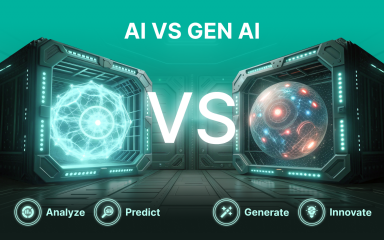In today’s digital age, technology has become essential to almost every business, from small startups to large enterprises. With the rapid advancement of technology, it has become increasingly challenging for companies to keep up with the latest developments and stay ahead of the competition. This is where IT outsourcing comes in, especially Staff Augmentation and Managed Services.
IT outsourcing is a business model where companies hire external contractors to perform IT functions. The outsourcing company provides various IT services, including staff augmentation and managed services. Staff augmentation is temporarily hiring additional IT professionals to work with the existing team. On the other hand, managed services involve outsourcing the entire IT department to a third-party vendor responsible for managing and maintaining all IT systems and services.
Choosing between IT staff augmentation and managed services depends on a company’s specific needs and objectives. Staff augmentation is ideal for companies that need additional IT resources for a short-term project. At the same time, managed services are better suited for businesses that want to outsource the entire IT department and focus on core business functions.
In this article, we will explore the differences between IT staff augmentation and managed services and help businesses determine which model best fits their IT outsourcing needs. We will also discuss the advantages and disadvantages of each model and provide insights into how companies can make an informed decisions when outsourcing their IT functions.
What Is IT Staff Augmentation?
Staff augmentation is an IT outsourcing strategy where a company hires external IT professionals temporarily to supplement its existing in-house team. Staff augmentation aims to increase the existing IT team’s capacity, skills, and flexibility. Also, business doesn’t have to commit to hiring full-time employees long-term.
Staff augmentation is usually needed in the following scenarios:
- Short-term projects
Staff augmentation can be cost-effective when a company needs additional IT resources for a short-term project, such as developing a new application or upgrading an existing system. By hiring IT professionals temporarily, companies can avoid the expenses associated with hiring and training full-time employees. - Urgent needs
Staff augmentation can provide a quick and effective solution when a company faces urgent IT needs, such as a system failure or a security breach. By hiring IT professionals with specialized skills, companies can address the problem quickly and minimize the impact on their operations. - Skills gaps
When a company lacks specific IT skills or expertise, staff augmentation can help fill the gap. By hiring IT professionals with the required skills and experience, companies can ensure the success of their projects and improve the overall quality of their IT services. - Capacity issues
When a company experiences a sudden increase in demand for IT services, staff augmentation can provide additional capacity to handle the workload. By hiring IT professionals temporarily, companies can avoid overburdening their existing IT team and ensure the timely delivery of their services.
Staff augmentation is a flexible and cost-effective solution that can help companies meet their short-term IT needs and improve their overall IT capabilities.
Types of Staff Augmentation
There are three principal types of staff augmentation: commodity, skill-based, and highly skilled. Each type of staff augmentation serves a different purpose and requires an extra level of expertise.
- Commodity Staff Augmentation
This type of staff augmentation focuses on providing IT personnel with basic technical skills, such as help desk support, data entry, or basic programming. Commodity staff augmentation is often used to fill temporary or entry-level positions. The personnel hired through this type of augmentation are typically expected to have little experience or specialized skills. - Skill-based Staff Augmentation
This type of staff augmentation focuses on providing IT personnel with specialized skills or expertise, such as cybersecurity, cloud computing, or mobile app development. Skill-based staff augmentation is often used to supplement in-house teams that lack specific skills or knowledge or to provide additional resources for short-term projects. The personnel hired through this type of augmentation are expected to have a higher level of technical expertise than those employed through commodity staff augmentation. - Highly-skilled Staff Augmentation
This type of staff augmentation provides IT personnel with advanced skills or expertise in areas such as artificial intelligence, blockchain, or data science. Highly-skilled staff augmentation is often used to supplement in-house teams that lack the resources or expertise to handle complex or specialized projects. The personnel hired through this type of augmentation are expected to have a high level of technical expertise and experience and may have advanced degrees or certifications in their field.
Overall, the type of staff augmentation a company uses will depend on its specific IT needs and the level of expertise required to meet those needs. Commodity staff augmentation may be appropriate for basic technical tasks, while skill-based staff augmentation may be necessary for specialized projects or expertise. Highly-skilled staff augmentation may be required for complex or cutting-edge projects that require advanced technical expertise.
Pros and Cons of the IT Staff Augmentation Model
Pros of the IT Staff Augmentation Model
- Focuses on Immediate Challenges
Staff augmentation allows businesses to quickly and effectively address immediate challenges, such as meeting project deadlines, without the long-term commitment of hiring full-time employees. - Closing Skills Gaps
Staff augmentation can help businesses fill skills gaps within their existing IT teams, providing access to specialized expertise and knowledge that may not be available in-house. - Controlling Costs
Staff augmentation can help businesses control costs by temporarily providing IT professionals access, despite the expenses associated with hiring and training full-time employees. - Greater Sense of Ownership for the Client
Because staff augmentation professionals work closely with in-house teams, they have a greater sense of ownership and commitment to the project’s success.
Cons of the IT Staff Augmentation Model
- Need for Training
Staff augmentation professionals may require training to become familiar with the business’s processes and systems, which can take time and resources. - Need for Management Resources
Staff augmentation professionals may require additional management resources to ensure they are integrated into the existing team and working effectively. - Better Suited for Short-Term IT Support
Staff augmentation is better suited for short-term IT support and may not be the best solution for long-term or ongoing projects.
It’s important to note that while hiring the augmentation team members, the existing team may not feel that their jobs are being threatened. However, new employee onboarding requires the same time and effort as the established team, and there may be some resistance to integrating the new members into the team. Additionally, staff augmentation is a more reactive solution than managed services, which can provide ongoing IT support and proactive solutions to prevent problems from arising in the first place.
What Is Managed IT Services?
Managed IT services involve outsourcing the management and maintenance of an organization’s IT infrastructure to a third-party provider. This can include services such as network management, data backup and recovery, software updates, and security management.
Organizations typically seek out outsourced IT support when they need more capital to hire and manage their own in-house IT teams. Managed IT services offer a range of benefits to organizations, including predictable pricing, the ability to scale services up or down as needed, and the ability to focus on core business concerns rather than IT management duties.
With managed IT services, organizations can benefit from the expertise and experience of a dedicated IT team without the costs associated with hiring and training full-time employees. Managed IT service providers also typically have access to the latest technologies and tools, which can help organizations stay up-to-date and competitive in their industry.
Another benefit of managed IT services is reducing downtime and minimizing the risk of IT-related issues. Managed IT service providers can proactively monitor IT infrastructure, identifying and addressing potential issues before they cause disruptions or downtime. This can help organizations maintain high productivity levels and minimize the impact of IT-related problems on their operations.
In summary, managed IT services offer organizations a cost-effective, scalable, and efficient solution to their IT management needs. With predictable pricing, access to the latest technologies, and a dedicated IT team, organizations can focus on their core business concerns and leave the management of their IT infrastructure to the experts.
Types of IT Managed Services
- Networking and Infrastructure
This type of managed service involves managing, monitoring, and maintaining an organization’s network and infrastructure. This can include services such as network design, installation, configuration, management, and ongoing monitoring and support. - Software as a Service (SaaS)
SaaS is a software delivery model in which software applications are hosted by a third-party provider and made available to customers online. Managed SaaS services provide ongoing maintenance, updates, and support for these applications, ensuring they are always up-to-date and functioning properly. - Security
Managed security services involve managing and monitoring an organization’s security infrastructure to identify and prevent threats. This can include services such as firewall management, intrusion detection, prevention, ongoing security monitoring, and incident response. - Support Services
Managed support services provide organizations with ongoing technical support for their IT infrastructure. This can include services such as help desk support, remote desktop support, and on-site support as needed. - IT Consulting
Managed IT consulting services provide organizations expert advice and guidance on IT-related matters. This can include services such as IT strategy development, project management, and technology assessments. - Cloud Infrastructure
Managed cloud infrastructure services involve managing and monitoring an organization’s cloud-based infrastructure, including services such as cloud migration, management, and support. These services are designed to help organizations take advantage of the benefits of cloud computing while minimizing the risks and complexities associated with managing cloud infrastructure.
In summary, managed IT services offer a range of benefits to organizations, providing expert support and management for IT infrastructure and applications. Whether organizations need support for networking and infrastructure, security, software as a service, support services, IT consulting, or cloud infrastructure, managed IT services can provide a cost-effective and efficient solution to their IT management needs.
Pros and Cons of IT Managed Services
Managed IT services have become increasingly popular with organizations of all sizes, providing benefits such as cost savings, expertise, and flexibility. However, some potential drawbacks should be considered.
Pros of the IT Managed Services
- Time and Cost Effective
Managed IT services can save costs by reducing the need for in-house IT resources and providing a predictable pricing model. They also offer time savings by providing expert support and management, allowing organizations to focus on core business activities. - Skills and Knowledge
Managed IT services provide access to a team of skilled IT professionals with expertise in various technologies and can offer specialized support as needed. - Flexibility
Managed IT services can be scaled up or down as needed to meet changing business requirements, providing flexibility and agility for organizations. - Monitoring
Managed IT services provide ongoing monitoring and management of IT infrastructure, helping prevent downtime and ensuring that systems function optimally. - Outcome
Managed IT services provide a predictable outcome for organizations, ensuring that IT infrastructure and applications are managed efficiently and effectively.
Cons of the IT Managed Services
- Actual Presence
Managed IT services may not provide an on-site physical presence, which can be challenging for organizations requiring hands-on support. - Higher Costs
Managed IT services can be more expensive than in-house IT resources, particularly if a high level of expertise is required. - Security and Control
Managed IT services require organizations to relinquish control of their IT infrastructure and applications to a third-party provider, which can raise concerns about security and management. - Switching Costs
Switching from one managed IT services provider to another can be costly and disruptive, particularly if significant changes to IT infrastructure are required. - Changing IT Needs
Managed IT services may not be able to keep up with rapidly changing IT needs, particularly in fast-paced industries or organizations.
In conclusion, while managed IT services can offer significant benefits for organizations, it is essential to carefully consider the potential drawbacks and assess whether this model fits the organization’s needs. So, when making this decision, the business should consider cost, expertise, control, and flexibility.
IT Staff Augmentation vs. Managed Services:
Which to Choose?
Regarding IT outsourcing, companies can choose between staff augmentation and managed services. Choosing the right one depends on the specific needs and priorities of the organization.
IT staff augmentation allows the organization to hire specialized IT professionals to support specific projects or tasks. This model can offer a greater sense of control and ownership for the client and be more cost-effective for short-term IT support. However, it requires management resources and may be unsuitable for long-term IT needs.
On the other hand, managed IT services provide ongoing support and management of IT infrastructure and applications, typically for a predictable monthly fee. This model can be more time and cost-effective, giving access to a team of skilled IT professionals without in-house resources. However, it requires relinquishing control of IT infrastructure and applications to a third-party provider, which may not be suitable for all organizations.
To determine which model is the best fit, companies should consider factors such as their budget, technical expertise, long-term IT needs, and desired level of control. Some companies may appreciate the flexibility and retained control of IT staff augmentation over managed services, while others may prefer the predictability and expertise offered by managed IT services.
In conclusion, while both methods of IT outsourcing save time and energy in recruiting IT specialists, it is essential to consider the pros and cons of each model to determine what suits the organization’s business model best. Ultimately, the right choice depends on the specific needs and priorities of the organization, and a thorough evaluation of the options should be conducted before making a decision.
Conclusion
Choosing between IT staff augmentation and managed services can be challenging for businesses. While both models offer benefits and drawbacks, the right choice depends on the specific needs and priorities of the organization.
At Bintime, we offer both IT staff augmentation and managed IT services, and we can work with our clienhttps://bintime.com/development-team/staff-augmentation/ts to understand their business needs and help them choose the most suitable approach. Whether you need a team of skilled IT professionals for a short-term project or ongoing support for your IT infrastructure, we can provide customized solutions tailored to your unique requirements.
In today’s fast-paced business environment, outsourcing IT support can provide a competitive advantage, allowing companies to focus on their core business concerns while leaving IT management to the experts. Contact Bintime now to discuss your IT outsourcing needs and find the best solution for your business.











